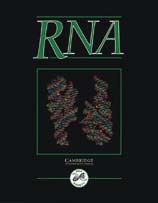Crossref Citations
This article has been cited by the following publications. This list is generated based on data provided by
Crossref.
Brunel, Christine
Marquet, Roland
Romby, Pascale
and
Ehresmann, Chantal
2002.
RNA loop–loop interactions as dynamic functional motifs.
Biochimie,
Vol. 84,
Issue. 9,
p.
925.
Henkin, Tina M.
and
Yanofsky, Charles
2002.
Regulation by transcription attenuation in bacteria: how RNA provides instructions for transcription termination/antitermination decisions.
BioEssays,
Vol. 24,
Issue. 8,
p.
700.
Gollnick, Paul
and
Babitzke, Paul
2002.
Transcription attenuation.
Biochimica et Biophysica Acta (BBA) - Gene Structure and Expression,
Vol. 1577,
Issue. 2,
p.
240.
Grundy, Frank J.
Winkler, Wade C.
and
Henkin, Tina M.
2002.
tRNA-mediated transcription antitermination
in vitro
: Codon–anticodon pairing independent of the ribosome
.
Proceedings of the National Academy of Sciences,
Vol. 99,
Issue. 17,
p.
11121.
Jester, Brian C.
Levengood, Jeffrey D.
Roy, Hervé
Ibba, Michael
and
Devine, Kevin M.
2003.
Nonorthologous replacement of lysyl-tRNA synthetase prevents addition of lysine analogues to the genetic code.
Proceedings of the National Academy of Sciences,
Vol. 100,
Issue. 24,
p.
14351.
Gerdeman, Melinda S.
Henkin, Tina M.
and
Hines, Jennifer V.
2003.
Solution Structure of the Bacillus subtilis T-box Antiterminator RNA: Seven Nucleotide Bulge Characterized by Stacking and Flexibility.
Journal of Molecular Biology,
Vol. 326,
Issue. 1,
p.
189.
YOUSEF, MARY R.
GRUNDY, FRANK J.
and
HENKIN, TINA M.
2003.
tRNA requirements for glyQS antitermination: A new twist on tRNA.
RNA,
Vol. 9,
Issue. 9,
p.
1148.
Yousef, Mary R.
Grundy, Frank J.
and
Henkin, Tina M.
2005.
Structural Transitions Induced by the Interaction between tRNAGly and the Bacillus subtilis glyQS T Box Leader RNA.
Journal of Molecular Biology,
Vol. 349,
Issue. 2,
p.
273.
Ryckelynck, Michaël
Giegé, Richard
and
Frugier, Magali
2005.
tRNAs and tRNA mimics as cornerstones of aminoacyl-tRNA synthetase regulations.
Biochimie,
Vol. 87,
Issue. 9-10,
p.
835.
Means, John A.
and
Hines, Jennifer V.
2005.
Fluorescence resonance energy transfer studies of aminoglycoside binding to a T box antiterminator RNA.
Bioorganic & Medicinal Chemistry Letters,
Vol. 15,
Issue. 8,
p.
2169.
Winkler, Wade C.
2005.
Metabolic monitoring by bacterial mRNAs.
Archives of Microbiology,
Vol. 183,
Issue. 3,
p.
151.
Winkler, Wade C.
and
Breaker, Ronald R.
2005.
REGULATION OF BACTERIAL GENE EXPRESSION BY RIBOSWITCHES.
Annual Review of Microbiology,
Vol. 59,
Issue. 1,
p.
487.
HENKIN, T.M.
and
GRUNDY, F.J.
2006.
Sensing Metabolic Signals with Nascent RNA Transcripts: The T Box and S Box Riboswitches as Paradigms.
Cold Spring Harbor Symposia on Quantitative Biology,
Vol. 71,
Issue. 0,
p.
231.
Means, John A.
Wolf, Steffen
Agyeman, Akwasi
Burton, Jeremy S.
Simson, Crystal M.
and
Hines, Jennifer V.
2007.
T Box Riboswitch Antiterminator Affinity Modulated by tRNA Structural Elements.
Chemical Biology & Drug Design,
Vol. 69,
Issue. 2,
p.
139.
Vitreschak, Alexey G.
Mironov, Andrei A.
Lyubetsky, Vassily A.
and
Gelfand, Mikhail S.
2008.
Comparative genomic analysis of T-box regulatory systems in bacteria.
RNA,
Vol. 14,
Issue. 4,
p.
717.
Fauzi, Hamid
Agyeman, Akwasi
and
Hines, Jennifer V.
2009.
T box transcription antitermination riboswitch: Influence of nucleotide sequence and orientation on tRNA binding by the antiterminator element.
Biochimica et Biophysica Acta (BBA) - Gene Regulatory Mechanisms,
Vol. 1789,
Issue. 3,
p.
185.
Jung, Samil
Chun, Jae-Yeon
Yim, Sei-Heun
Lee, Soo-Suk
Cheon, Choong-Il
Song, Eunsook
and
Lee, Myeong-Sok
2010.
Transcriptional regulation of histidine biosynthesis genes in Corynebacterium glutamicum.
Canadian Journal of Microbiology,
Vol. 56,
Issue. 2,
p.
178.
Green, Nicholas J.
Grundy, Frank J.
and
Henkin, Tina M.
2010.
The T box mechanism: tRNA as a regulatory molecule.
FEBS Letters,
Vol. 584,
Issue. 2,
p.
318.
Wang, Jiachen
Henkin, Tina M.
and
Nikonowicz, Edward P.
2010.
NMR structure and dynamics of the Specifier Loop domain from the Bacillus subtilis tyrS T box leader RNA.
Nucleic Acids Research,
Vol. 38,
Issue. 10,
p.
3388.
Tan, Yang
Liu, Juanjuan
Chen, Xiaohua
Zheng, Huajun
and
Li, Fuli
2013.
RNA-seq-based comparative transcriptome analysis of the syngas-utilizing bacterium Clostridium ljungdahlii DSM 13528 grown autotrophically and heterotrophically.
Molecular BioSystems,
Vol. 9,
Issue. 11,
p.
2775.




